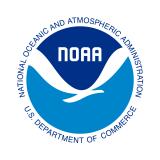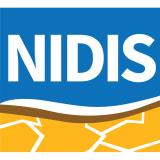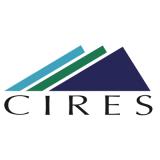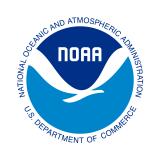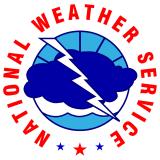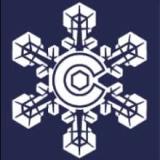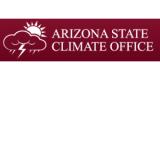Wet Start for the Monsoon over Drought-Stricken Southwest.
The North American Monsoon brings summer precipitation to parts of the Southwestern U.S. and Mexico. The monsoon season is June 15 to September 30, though the actual arrival of the monsoon can vary.
Key Points
- Over the past year, drought developed and intensified in the Four Corners region and southern California and Nevada, with the most intense drought conditions in Arizona and New Mexico.
- The 2025 North American Monsoon began the week of June 23 in parts of New Mexico and West Texas, bringing helpful rains to drought-stricken areas but also dangerous flooding. Other states (Arizona, Colorado, California, Nevada, Utah) await their first monsoonal precipitation.
- Monsoonal rainfall only provides a fraction of the West's water supplies, with the majority coming from snowpack. However, it can meaningfully reduce local drought impacts by reducing demand for water stored in reservoirs, recharging soil moisture and groundwater, benefitting agricultural production by improving grassland health for livestock and filling stock ponds, and reducing wildfire risk.
- Outlooks favor above-normal monsoonal precipitation for the Southwestern U.S. in July. This could improve drought conditions and provide short-term relief, but dry landscape conditions leading into the monsoon mean drought is likely to persist. NOAA’s Climate Prediction Center predicts drought improvement (but not removal) for the area near the Arizona-New Mexico border in July.
- However, precipitation in the first half of July is not a predictor of precipitation during the rest of the Monsoon season. Tracking conditions and outlooks as summer progresses will be especially important.
This update is based on data available as of Monday, June 30, 2025 at 8:00 a.m. MT. We acknowledge that conditions are evolving.
In This Update:
- What Is the North American Monsoon? Why Does It Matter?
- How Does the Monsoon Impact Drought in the Southwest?
- What Is the Drought Status Going into the North American Monsoon?
- Will the North American Monsoon Be Active through September? What Does This Mean for Drought?
- Additional Resources
What Is the North American Monsoon? Why Does It Matter?
- The North American Monsoon brings summer precipitation to parts of the Southwestern U.S. and Mexico, typically beginning in mid- to late June and lasting through September. This pattern results in active thunderstorms across Arizona, New Mexico, Colorado, and southern/eastern Utah. Monsoonal surges can also occur outside of these "core" areas, reaching Nevada, southeastern California, Far West Texas, and Wyoming.
- The North American Monsoon is a seasonal wind shift that occurs between June 15–September 30, depending on geographic location. The monsoonal flow allows moisture to move into the Southwestern U.S., which provides a needed ingredient for thunderstorm activity.
- The development of a ridge of persistent high pressure near the Four Corners region in the Southwest often initiates monsoon activity by providing a more moist, southerly flow from the subtropics around North America. Learn more about monsoon dynamics.
- The monsoon can vary in intensity and location from year to year. A more active monsoon season can moderate hot conditions with more thunderstorm activity, increase soil moisture, and reduce land surface temperatures, and improve drought conditions.
How Does the Monsoon Impact Drought in the Southwest?
- Rainfall associated with the monsoon is very important for the Southwest U.S. Parts of Arizona and New Mexico receive as much as 10-60% of their annual precipitation during the monsoon season (data for June-August).
- The position of the high pressure system can shift throughout the season, which determines if Arizona or New Mexico will get more or less rain. This can sometimes result in rapid drought improvement or onset.
- A weak or inactive monsoon season can worsen short- and long-term drought conditions. For example, the inactive 2023 Monsoon Season resulted in significant drought expansion for New Mexico and Arizona. Meanwhile, an average to above-average monsoon can potentially improve or remove drought conditions, such as the 2022 North American Monsoon, which was the 9th wettest on record and significantly improved drought conditions in Arizona and New Mexico.
- The monsoon has a lesser influence in Nevada and California, though areas of southern Nevada and southeastern California occasionally receive significant monsoonal precipitation. On average, 20-25% of southern Nevada’s precipitation falls during the summer.
- Even in states where an outsized portion of annual water supply is derived from snowpack, monsoonal rainfall can still meaningfully reduce local impacts. For example, monsoonal precipitation can reduce demand for water stored in reservoirs, recharge groundwater, benefit agricultural production by improving grassland health for livestock and filling stock ponds, and reduce wildfire risk.
North American Monsoon Precipitation Is a Major Contributor to Southwestern Annual Rainfall
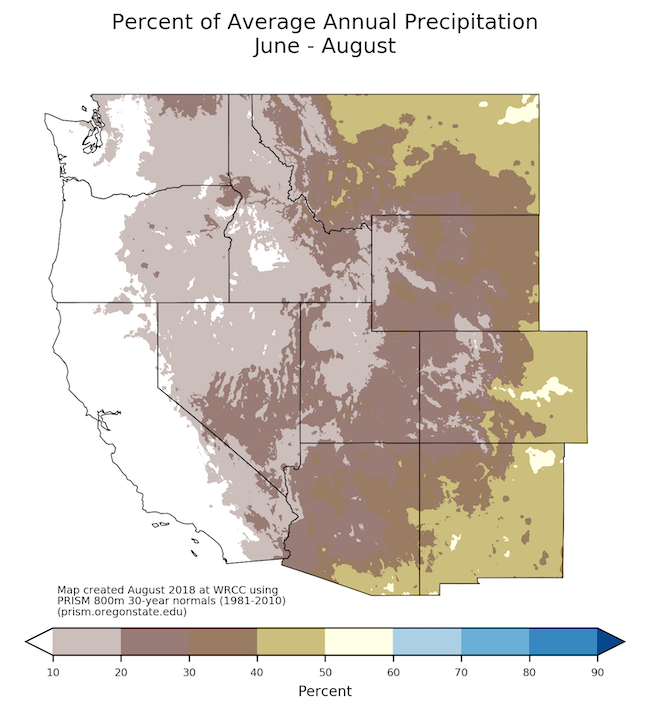
What Is the Drought Status Going into the North American Monsoon?
- As of June 24, every state in the Southwest (and California) is experiencing some level of drought (D1-D4), according to the U.S. Drought Monitor :
- 97.33% of Arizona
- 39.29% of California (primarily in southern California)
- 45.47% of Colorado
- 50.60% of Nevada
- 80.20% of New Mexico
- 91.10% of Utah
- National Weather Service offices throughout the Southwest have issued drought information statements describing local drought conditions and impacts, including for:
- South-central and southwest Arizona and southeast California (NWS Phoenix)
- Western Colorado and eastern Utah (NWS Grand Junction)
- Mojave Desert and eastern Sierra (NWS Las Vegas)
- Utah and Uinta County, Wyoming (NWS Salt Lake City)
- In Arizona and New Mexico, drought conditions have expanded since summer 2024. Drought intensified and expanded northward and westward into southern Nevada and California due to a dry summer in 2024 followed by a dry fall and winter. Some areas (e.g., Arizona, southern California, and Nevada) saw slight improvement this spring, but drought persists.
- Looking back 12 months to the start of the last monsoon (June 2024) until now (May 2025), Arizona experienced its 3rd driest and Nevada its 13th driest June–May, going back 130 years. Some areas were worse at the county scale. Yuma and Maricopa counties in Arizona; Imperial County, California; and Clark County, Nevada experienced June-May periods in the top three driest on record.
- Utah, New Mexico, and the Navajo Nation have already declared drought emergencies.
Widespread Southwestern Drought at the Start of Monsoon Season (June 24, 2025)
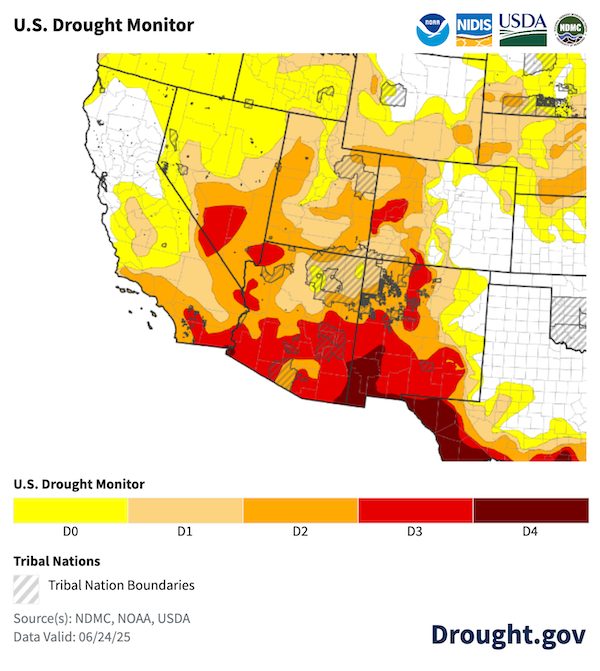
Low Statewide Precipitation Over the Past Year
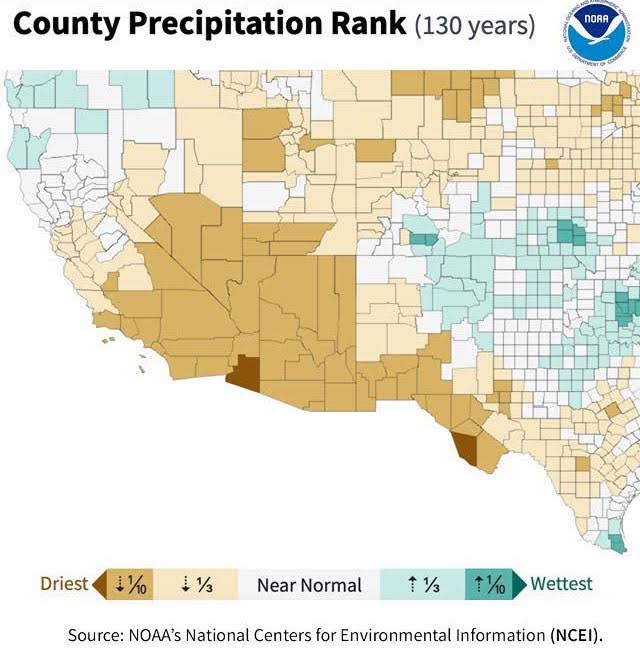
Will the North American Monsoon Be Active through September? What Does This Mean for Drought?
- Seasonal forecasts of monsoon precipitation are largely based on continental or global-scale influences (e.g., sea surface temperature patterns), while actual rainfall totals for a given location are influenced by local-scale factors (e.g., local landscape, humidity, and temperatures), some of which can change quickly and over short distances. As a result, there is greater uncertainty in monsoonal precipitation forecasts for specific locations than when considering the Southwest region as a whole.
- The Southwestern U.S. is forecast to be wetter than normal through at least mid- to late July. However, precipitation in the first half of July is not a predictor of precipitation during the rest of the monsoon season.
- For the 2025 Monsoon Season, NOAA’s Climate Prediction Center’s seasonal outlooks favor above-normal temperatures and equal chances of below-normal, normal, and above-normal precipitation across most of the Southwestern U.S. An “equal chances” outlook does not necessarily mean normal, or average, rainfall can be expected. Rather, it implies that there is nothing in the climate system (including the El Nino-Southern Oscillation, which is currently neutral) that is pushing weather patterns toward one extreme or the other and any scenario is possible.
- Drought is predicted to persist in much of the region over the next month and the summer months, with potential drought improvements (but not removal) in the “core” monsoon region at the Arizona-New Mexico border.
- Given these outlooks, wildfire risk is forecasted to be near normal for parts of the Southwest that normally have good summer precipitation from the monsoon.
- For short-term forecasts, see the Quantitative Precipitation Forecast (QPF) or your local National Weather Service Weather Forecast Office.
Odds Favor Wet Start for the Monsoon through Mid- to Late July
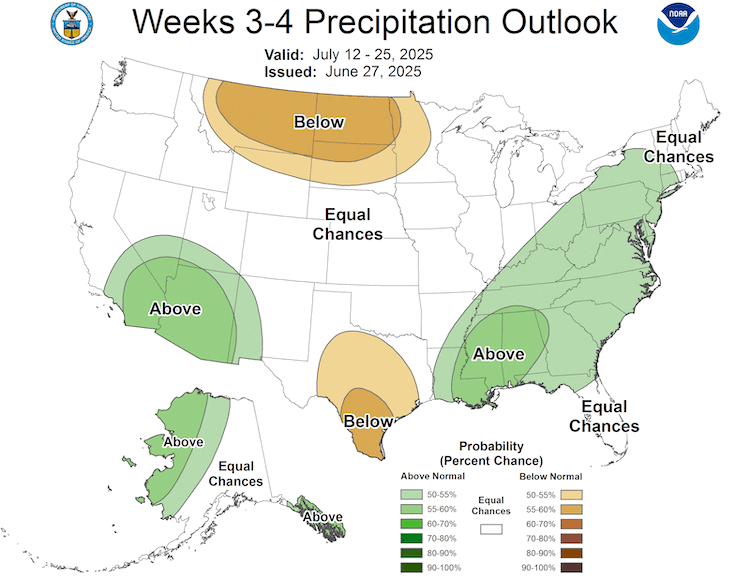
Drought Predicted to Improve in Parts of Arizona/New Mexico in July, But Otherwise Persist
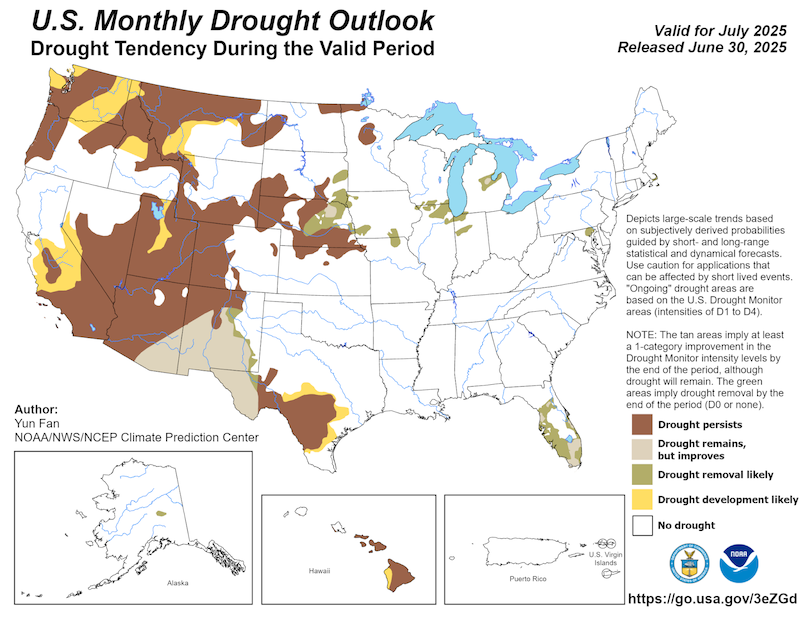
Potential Impacts of North American Monsoon Precipitation for Drought
Monsoon Impacts | Below-Average Precipitation | Near-Average Precipitation | Above-Average Precipitation |
|---|---|---|---|
| Impact on Drought | Long- and short-term drought in the region would worsen, potentially similar to what happened in summer 2023. | Short-term drought improvement is possible. | This could help improve long- and short-term drought in the Southwest, but the potential for hazardous flash flooding would increase. |
| Water Storage | Increased reservoir storage and groundwater depletion as municipal and agricultural demand increase during hot season. | An average-to-above average monsoon can increase water storage and replenish stock ponds in parts of the region, but not by significant amounts. Research has shown that summer precipitation is less efficient than winter precipitation at alleviating hydrologic drought. However, a more active monsoon reduces outdoor water demand, which has a positive impact on water supply. | |
| Wildland Fire | Elevated wildland fire potential to continue through summer. | Fire potential to return to near normal for this time of year. Lightning can be a source for fire ignition. | Fire potential to return to near normal for this time of year. |
Potential drought impacts if the Southwest receives below-average, near-average, or above-average precipitation during the 2025 North American Monsoon Season.
Additional Resources
- More local information is available from the following resources:
- More state information is available from the following resources
- Arizona: Interactive Drought Dashboard; State Climate Office
- California: California Water Watch; California Department of Water Resources - Drought; California State Climatologist
- Colorado: Water Conditions Monitoring Committee; Colorado Climate Center Drought Dashboard
- Nevada: Living with Drought in Nevada; Nevada Division of Water Resources - Drought; State Climate Office
- New Mexico: Office of the State Engineer, Drought page; New Mexico Climate Center
- Utah: Department of Natural Resources, Drought page; Utah Climate Center
- Climate Assessment for the Southwest (a NOAA CAP/RISA team)
- Local NOAA National Weather Service information on the monsoon:
- To report or view local drought impact information:
Prepared By
Amanda Sheffield, Elise Osenga, Jason Gerlich, Joel Lisonbee, Kelsey Satalino Eigsti, Adam Lang, Eleanor Hasenbeck
University of Colorado Boulder/Cooperative Institute for Research in Environmental Sciences (CIRES), NOAA/National Integrated Drought Information System (NIDIS)
Meredith Muth
NOAA/National Integrated Drought Information System (NIDIS)
Andrew Hoell
NOAA/Physical Sciences Laboratory
Dan McEvoy
Western Regional Climate Center/Desert Research Institute
Dave Simeral
Western Regional Climate Center/Desert Research Institute
Erinanne Saffell
Arizona State Climate Office at Arizona State University
Mark O’Malley
NOAA National Weather Service Phoenix Weather Forecast Office
Russ Schumacher
Colorado Climate Center at Colorado State University
Julie Kalansky
California-Nevada Adaptation Program (a NOAA CAP/RISA team)
This Drought Status Update is issued in partnership between the National Oceanic and Atmospheric Administration (NOAA) and partner in the Intermountain West and California-Nevada to communicate a potential area of concern for drought expansion and/or development within the Intermountain West and California-Nevada region based on recent conditions and the upcoming forecast. NIDIS and its partners will issue future Drought Status Updates as conditions evolve.


